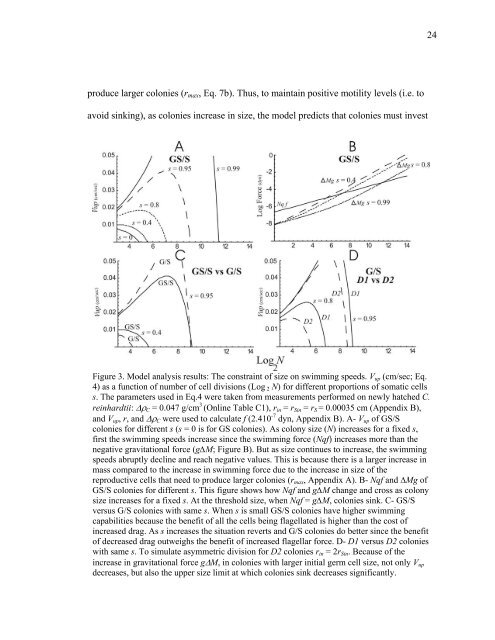Dissertation Proposal - The University of Arizona Campus Repository
Dissertation Proposal - The University of Arizona Campus Repository
Dissertation Proposal - The University of Arizona Campus Repository
Create successful ePaper yourself
Turn your PDF publications into a flip-book with our unique Google optimized e-Paper software.
produce larger colonies (rmax, Eq. 7b). Thus, to maintain positive motility levels (i.e. to<br />
avoid sinking), as colonies increase in size, the model predicts that colonies must invest<br />
Figure 3. Model analysis results: <strong>The</strong> constraint <strong>of</strong> size on swimming speeds. Vup (cm/sec; Eq.<br />
4) as a function <strong>of</strong> number <strong>of</strong> cell divisions (Log 2 N) for different proportions <strong>of</strong> somatic cells<br />
s. <strong>The</strong> parameters used in Eq.4 were taken from measurements performed on newly hatched C.<br />
reinhardtii: ∆ρC = 0.047 g/cm 3 (Online Table C1), rin = rSin = rS = 0.00035 cm (Appendix B),<br />
and Vup, r, and ∆ρC were used to calculate f (2.410 -7 dyn, Appendix B). A- Vup <strong>of</strong> GS/S<br />
colonies for different s (s = 0 is for GS colonies). As colony size (N) increases for a fixed s,<br />
first the swimming speeds increase since the swimming force (Nqf) increases more than the<br />
negative gravitational force (g∆M; Figure B). But as size continues to increase, the swimming<br />
speeds abruptly decline and reach negative values. This is because there is a larger increase in<br />
mass compared to the increase in swimming force due to the increase in size <strong>of</strong> the<br />
reproductive cells that need to produce larger colonies (rmax, Appendix A). B- Nqf and ∆Mg <strong>of</strong><br />
GS/S colonies for different s. This figure shows how Nqf and g∆M change and cross as colony<br />
size increases for a fixed s. At the threshold size, when Nqf = g∆M, colonies sink. C- GS/S<br />
versus G/S colonies with same s. When s is small GS/S colonies have higher swimming<br />
capabilities because the benefit <strong>of</strong> all the cells being flagellated is higher than the cost <strong>of</strong><br />
increased drag. As s increases the situation reverts and G/S colonies do better since the benefit<br />
<strong>of</strong> decreased drag outweighs the benefit <strong>of</strong> increased flagellar force. D- D1 versus D2 colonies<br />
with same s. To simulate asymmetric division for D2 colonies rin = 2rSin. Because <strong>of</strong> the<br />
increase in gravitational force g∆M, in colonies with larger initial germ cell size, not only Vup<br />
decreases, but also the upper size limit at which colonies sink decreases significantly.<br />
24

















